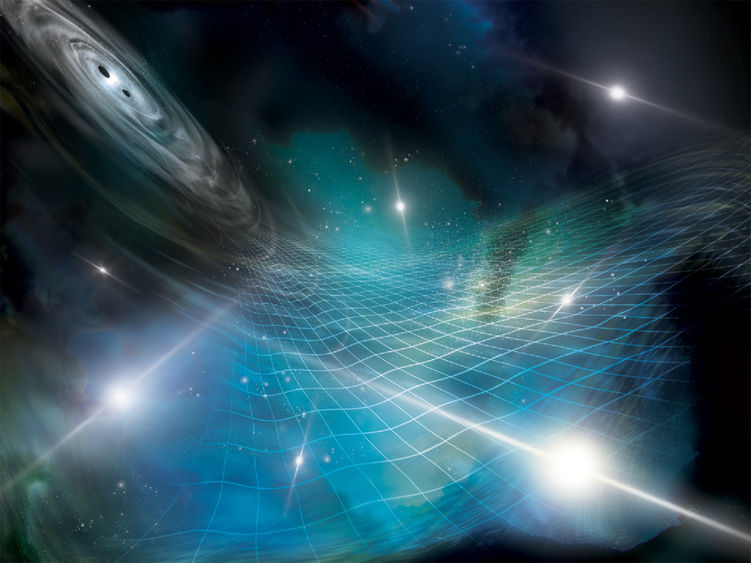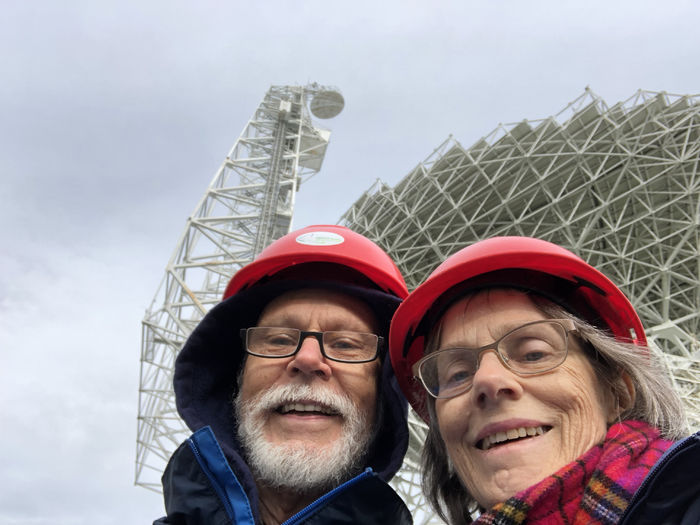
The NANOGrav Collaboration has found the first evidence for low-frequency gravitational waves permeating the cosmos. This finding was made possible with 15 years of pulsar observations that turn the Milky Way into a galaxy-sized gravitational-wave detector.
ABINGTON, Pa. — An international team of astrophysicists, including researchers from Penn State Abington, have used large radio telescopes to observe a collection of "cosmic clocks" in our galaxy to find evidence for gravitational waves that oscillate with periods of years to decades, according to a set of papers published today in the Astrophysical Journal Letters.
The gravitational-wave signal was observed in 15 years of data acquired by the North American Nanohertz Observatory for Gravitational Waves (NANOGrav) Physics Frontiers Center (PFC), a collaboration of more than 190 scientists from the U.S. and Canada who use pulsars to search for gravitational waves. International collaborations using telescopes in Europe, India, Australia and China have independently reported similar results.
Ann Schmiedekamp and Carl Schmiedekamp, both physicists from Penn State Abington, have been a part of the NANOGrav collaboration for four years and are coauthors on all papers published today (June 28) in Astrophysical Journal Letters.
“This evidence of gravitational waves with oscillations of years to decades, opens a new window to our universe,” they said. “We have been only a small part of an immense effort with hundreds of outstanding scientists.”
While earlier results from NANOGrav uncovered an enigmatic timing signal common to all the pulsars they observed, they said, it was too faint to reveal its origin. The 15-year data release demonstrates that the signal is consistent with slowly undulating gravitational waves passing through our galaxy.
“This is key evidence for gravitational waves at very low frequencies,” said Vanderbilt University’s Stephen Taylor, who co-led the search and is the current chair of the collaboration. “After years of work, NANOGrav is opening an entirely new window on the gravitational-wave universe."
Unlike the fleeting high-frequency gravitational waves seen by ground-based instruments like LIGO (the Laser Interferometer Gravitational-Wave Observatory), this continuous low-frequency signal could be perceived only with a detector much larger than the Earth. To meet this need, astronomers turned our sector of the Milky Way galaxy into a huge gravitational-wave antenna by making use of exotic stars called pulsars. NANOGrav’s 15-year effort collected data from 68 pulsars to form a type of detector called a pulsar timing array.
A pulsar is the ultra-dense remnant of a massive star's core following its demise in a supernova explosion. Pulsars spin rapidly, sweeping beams of radio waves through space so that they appear to “pulse” when seen from the Earth. The fastest of these objects, called millisecond pulsars, spin hundreds of times each second. Their pulses are very stable, making them useful as precise cosmic timepieces.
Over 15 years of observations with the Arecibo Observatory in Puerto Rico, the Green Bank Telescope in West Virginia, and the Very Large Array in New Mexico, NANOGrav has gradually expanded the number of pulsars they observe.
“Pulsars are actually very faint radio sources, so we require thousands of hours a year on the world’s largest telescopes to carry out this experiment,” explained Maura McLaughlin of West Virginia University, who is co-director of the NANOGrav PFC.
Einstein’s theory of general relativity predicts precisely how gravitational waves should affect pulsar signals. By stretching and squeezing the fabric of space, gravitational waves affect the timing of each pulse in a small but predictable way, delaying some while advancing others. These shifts are correlated for all pairs of pulsars in a way that depends on how far apart the two stars appear in the sky.
“The large number of pulsars used in the NANOGrav analysis has enabled us to see what we think are the first signs of the correlation pattern predicted by general relativity,” said Oregon State University’s Xavier Siemens, co-director of the NANOGrav PFC.
NANOGrav’s most recent dataset shows growing evidence for gravitational waves with periods of years to decades. These waves could arise from orbiting pairs of the most massive black holes in the entire Universe: billions of times more massive than the sun, with sizes larger than the distance between the Earth and the sun. Future studies of this signal could open a new window on the gravitational-wave universe, providing insight into titanic black holes merging in the hearts of distant galaxies, among other exotic sources, said the researchers.
Ann and Carl Schmiedekamp have been primarily involved in NANOGrav’s outreach activities. NANOGrav has programs for high school students and undergraduates through the Pulsar Science Collaboration (PSC) and the two researchers have been advisers to the PSC advanced group on giant pulses and helped with other PSC activities. They have also run an ongoing undergraduate research program in pulsar astronomy at the Abington campus through the ACURA program.
Support from the National Science Foundation (NSF) has been critical to NANOGrav’s success by providing support for scientific work through the Physics Frontiers Center program and through access to multiple world-class radio telescopes. Future NANOGrav results will incorporate data from Canada’s CHIME telescope, added to the project in 2019.
"The NSF NANOGrav team created, in essence, a galaxy-wide detector revealing the gravitational waves that permeate our universe," said NSF Director Sethuraman Panchanathan. "The collaboration involving research institutions across the U.S. shows that world-class scientific innovation can, should and does reach every part of our nation.”
Astrophysicists around the globe have been busy chasing this gravitational-wave signal, according to the reserachers. Several papers released today by the Parkes Pulsar Timing Array in Australia, the Chinese Pulsar Timing Array, and the European Pulsar Timing Array/Indian Pulsar Timing Array report hints of the same signal in their data. Through the International Pulsar Timing Array consortium, regional collaborations are working together to combine their data in order to better characterize the signal and search for new types of sources.
“Our combined data will be much more powerful,” said Taylor. “We’re excited to discover what secrets they will reveal about our Universe.”
The NANOGrav collaboration receives support from National Science Foundation Physics Frontiers Center, the Gordon and Betty Moore Foundation, NSF AccelNet, a Natural Sciences and Engineering Research Council of Canada Discovery Grant, and the Canadian Institute for Advanced Research. The Arecibo Observatory is a facility of the National Science Foundation by the University of Central Florida in alliance with Universidad Ana G. Méndez and Yang Enterprises Inc. The Green Bank Observatory and The National Radio Astronomy Observatory are facilities of the National Science Foundation operated under cooperative agreements by Associated Universities Inc.






